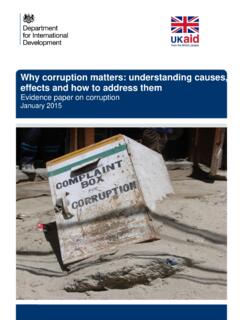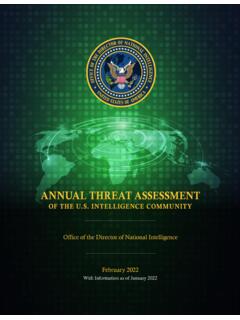Transcription of The Ripple Protocol Consensus Algorithm
1 Ripple Labs Inc, 2014 The Ripple Protocol Consensus AlgorithmDavid several Consensus algorithms exist for the Byzantine Generals Problem, specifically as itpertains to distributed payment systems, many suffer from high latency induced by the requirementthat all nodes within the network communicate synchronously. In this work, we present a novelconsensus Algorithm that circumvents this requirement by utilizing collectively-trusted subnetworkswithin the larger network. We show that the trust required of these subnetworks is in fact minimaland can be further reduced with principled choice of the member nodes. In addition, we show thatminimal connectivity is required to maintain agreement throughout the whole network. The result is alow-latency Consensus Algorithm which still maintains robustness in the face of Byzantine failures.
2 Wepresent this Algorithm in its embodiment in the Ripple , Formalization and Previous Work Ripple Protocol Components .. Formalization .. Existing Consensus Algorithms .. Formal Consensus Goals .. 33 Ripple Consensus Definition .. Correctness .. Agreement .. Utility .. 5 Convergence Heuristics and Procedures4 Simulation Code75 Discussion76 Acknowledgments8 References81. IntroductionInterest and research in distributed Consensus systemshas increased markedly in recent years, with a centralfocus being on distributed payment networks. Such net-works allow for fast, low-cost transactions which are notcontrolled by a centralized source. While the economicbenefits and drawbacks of such a system are worthy ofmuch research in and of themselves, this work focuseson some of the technical challenges that all distributedpayment systems must face.
3 While these problems arevaried, we group them into three main categories: cor-rectness, agreement, and correctness, we mean that it is necessary for adistributed system to be able to discern the difference be-tween a correct and fraudulent transaction. In traditionalfiduciary settings, this is done through trust betweeninstitutions and cryptographic signatures that guaranteea transaction is indeed coming from the institution thatit claims to be coming from. In distributed systems,however, there is no such trust, as the identity of anyand all members in the network may not even be , alternative methods for correctness must refers to the problem of maintaining asingle global truth in the face of a decentralized account-ing system. While similar to the correctness problem,the difference lies in the fact that while a malicioususer of the network may be unable to create a fraudu-lent transaction (defying correctness), it may be able tocreate multiple correct transactions that are somehowunaware of each other, and thus combine to create afraudulent act.
4 For example, a malicious user may maketwo simultaneous purchases, with only enough funds intheir account to cover each purchase individually, butnot both together. Thus each transaction by itself iscorrect, but if executed simultaneously in such a waythat the distributed network as a whole is unaware ofboth, a clear problem arises, commonly referred to asthe Double-Spend Problem [1]. Thus the agreementproblem can be summarized as the requirement that onlyone set of globally recognized transactions exist in is a slightly more abstract problem, which wedefine generally as the usefulness of a distributed pay-ment system, but which in practice most often simplifiesto the latency of the system. A distributed system thatis both correct and in agreement but which requires oneyear to process a transaction, for example, is obviouslyan inviable payment system.
5 Additional aspects of util-ity may include the level of computing power requiredto participate in the correctness and agreement processesor the technical proficiency required of an end user toavoid being defrauded in the of these issues have been explored long beforethe advent of modern distributed computer systems, viaa problem known as the Byzantine Generals Problem [2]. In this problem, a group of generals each controla portion of an army and must coordinate an attack bysending messengers to each other. Because the gener-als are in unfamiliar and hostile territory, messengersmay fail to reach their destination (just as nodes in adistributed network may fail, or send corrupted data in-stead of the intended message). An additional aspectof the problem is that some of the generals may betraitors, either individually, or conspiring together, andso messages may arrive which are intended to create afalse plan that is doomed to failure for the loyal gener-als (just as malicious members of a distributed systemmay attempt to convince the system to accept fraudulenttransactions, or multiple versions of the same truthfultransaction that would result in a double-spend).
6 Thusa distributed payment system must be robust both inthe face of standard failures, and so-called Byzantine failures, which may be coordinated and originate frommultiple sources in the this work, we analyze one particular implemen-tation of a distributed payment system: the Ripple Pro-tocol. We focus on the algorithms utilized to achievethe above goals of correctness, agreement, and utility,and show that all are met (within necessary and predeter-mined tolerance thresholds, which are well-understood).In addition, we provide code that simulates the consen-sus process with parameterizable network size, numberof malicious users, and message-sending Definitions, Formalization andPrevious WorkWe begin by defining the components of the RippleProtocol. In order to prove correctness, agreement, andutility properties, we first formalize those properties intoaxioms.
7 These properties, when grouped together, formthe notion ofconsensus: the state in which nodes in thenetwork reach correct agreement. We then highlightsome previous results relating to Consensus algorithms,and finally state the goals of Consensus for the RippleProtocol within our formalization Ripple Protocol ComponentsWe begin our description of the Ripple network by defin-ing the following terms: Server:A server is any entity running the RippleServer software (as opposed to the Ripple Clientsoftware which only lets a user send and receivefunds), which participates in the Consensus pro-cess. Ledger:The ledger is a record of the amountof currency in each user s account and representsthe ground truth of the network. The ledger isrepeatedly updated with transactions that success-fully pass through the Consensus process.
8 Last-Closed Ledger:The last-closed ledger isthe most recent ledger that has been ratified by theconsensus process and thus represents the currentstate of the network. Open Ledger:The open ledger is the currentoperating status of a node (each node maintainsits own open ledger). Transactions initiated byend users of a given server are applied to the open2ledger of that server, but transactions are not con-sidered final until they have passed through theconsensus process, at which point the open ledgerbecomes the last-closed ledger. Unique Node List (UNL):Each server,s, main-tains a unique node list, which is a set of otherservers thatsqueries when determining consen-sus. Only the votes of the other members of theUNL ofsare considered when determining con-sensus (as opposed to every node on the network).Thus the UNL represents a subset of the networkwhich when taken collectively, is trusted bysto not collude in an attempt to defraud the net-work.
9 Note that this definition of trust does notrequire that each individual member of the UNLbe trusted (see section ). Proposer:Any server can broadcast transactionsto be included in the Consensus process, and everyserver attempts to include every valid transactionwhen a new Consensus round starts. During theconsensus process, however, only proposals fromservers on the UNL of a serversare FormalizationWe use the termnonfaultyto refer to nodes in the net-work that behave honestly and without error. Conversely,afaultynode is one which experiences errors which maybe honest (due to data corruption , implementation er-rors, etc.), or malicious (Byzantine errors). We reducethe notion of validating a transaction to a simple binarydecision problem: each node must decide from the in-formation it has been given on the value 0 or in Attiya, Dolev, and Gill, 1984 [3], we defineconsensus according to the following three axioms:1.
10 (C1):Every nonfaulty node makes a decision infinite time2.(C2):All nonfaulty nodes reach the same deci-sion value3.(C3):0 and 1 are both possible values for all non-faulty nodes. (This removes the trivial solutionin which all nodes decide 0 or 1 regardless of theinformation they have been presented). Existing Consensus AlgorithmsThere has been much research done on algorithms thatachieve Consensus in the face of Byzantine errors. Thisprevious work has included extensions to cases where allparticipants in the network are not known ahead of time,where the messages are sent asynchronously (there isno bound on the amount of time an individual node willtake to reach a decision), and where there is a delineationbetween the notion of strong and weak pertinent result of previous work on consen-sus algorithms is that of Fischer, Lynch, and Patterson,1985 [4], which proves that in the asynchronous case,non-termination is always a possibility for a consen-sus Algorithm , even with just one faulty process.



